Amid the West’s Efforts to Ban Russian Diamonds, a ‘Big Loophole’ Is Exploited by India and ‘Israel’

In the past decades, the name "blood diamonds" has been associated with the struggles of repressive African regimes that used to buy weapons from Western countries through diamond deals extracted through the forced labor system.
With the start of Russia's invasion of Ukraine, the same name was repeated frequently with the efforts of Western countries, led by the United States, to ban Russian diamonds and remove them from the global market by classifying them as "related to conflicts" as well.
However, several obstacles stand in front of this scheme, the most important of which are India's relations with Russia, in addition to the Israeli mafia networks that are closely intertwined with the Russian diamond industry.
'Precious' Battle
The New York Times revealed on August 16, 2022, that the United States and other countries have begun to take measures that may contribute to the classification of Russian diamonds as "conflict-related" and say that its sales contribute to financing the Russian invasion of Ukraine.
The American newspaper reported that European countries that have reduced their dependence on Russian oil and gas have begun to move to another vital sector, which is diamonds extracted from the frozen regions of northeastern Russia.

For years, Russia has been the largest supplier of small diamonds to the United States, which are used to make earrings, bracelets, and wedding rings.
In a May 2022 letter to the board of directors of the Kimberley Process organization, which the United Nations established to prevent the flow of diamonds intended to support conflicts, US State Department official George Cajati said that the proceeds from that production benefit Russia, which is waging an intentional, unjustified war.
The European Union, Canada, and other Western countries, in addition to Ukraine and a number of activist organizations, joined similar calls for the organization because the Russian gemstones are "conflict-supporting diamonds," which is known as the blood diamond.
In 2003, the United Nations established the Kimberley Process organization in light of the diamond sales funding for the bloody war in Sierra Leone, and the organization defines these stones as the rough diamonds used by the rebel movements or their allies to finance the conflict aimed at eliminating legitimate governments.
Tough Obstacles
On the other hand, Russia confirmed that its diamonds meet environmental, social, and administrative standards even before it was famous around the world, and the sales of these gemstones contributed to the recovery of remote parts of the country.
The Russian Finance Ministry said in a statement reported by The New York Times that the proceeds from the diamonds contributed to paving roads and building schools and hospitals, noting that the payments reach private organizations or companies.
The way of life of a million people in the remote Yakutia region depends entirely on the stability of diamond mining in the region, and the calls of the West to ban it is unacceptable, she added.
In a letter dated May 20, 2022, Russia's Kimberley delegate responded to the Western efforts, stressing that the situation in Ukraine "has no implications" for the Kimberley Process and is "outside the scope" of its ratification plan, according to the newspaper.
Russia, backed by Belarus, the Central African Republic, Kyrgyzstan, and Mali, ended up aborting the Western proposal to veto the International Diamond Meeting in Botswana, Reuters reported on June 12, 2022.
Bloomberg reported on August 23 that exports from the sanctioned Russian mining company Alrosa had returned to pre-war levels.
Alrosa has resumed selling diamonds at more than $250 million a month, which is $50-100 million less than its average pre-war sales in Ukraine.
Big holes
Russia overcomes the Western blockade by shipping most of its diamonds abroad for polishing, especially in India, which has not joined the sanctions imposed on Moscow. The diamonds mined in Russia are no longer classified as Indian, according to the New York Times.
India is a source for Western companies to buy low-quality diamonds, which are sold at lower prices, so tracing Russian diamonds among all the small stones is an impossible task, and they can easily be sold in stores without knowing their source, according to Time magazine.
The Hebrew newspaper, Haaretz, confirmed in an April 13, 2022, report that Israeli diamond dealers are financing Putin's war machine in Ukraine.
Despite the new sanctions over the Ukraine war, there is a loophole that allows dealers to sell Russian diamonds in the United States, as long as they are first polished in "Israel" and classified as Israeli, not Russian, the newspaper said.
On March 14, 2022, the French newspaper Le Point indicated that criminal organizations in Russia and "Israel" could help the Russian diamond sector to circumvent sanctions by buying Russian diamonds without disclosing its source by Israeli brokers.
On June 3, 2022, Agence France-Presse said that the diamond trade is an essential axis in Israeli-Indian relations, and India plays a role in marketing Russian diamonds.
In 2009, the United Nations Committee of Experts officially accused "Israel" of being involved in illegally exporting blood diamonds from African countries, including Ivory Coast and Sierra Leone.
Because of these Israeli thefts of African diamonds and the concentration of major Jewish traders in the diamond trade in Europe, "Israel" has turned into a global name in the diamond trade.
"Israel" seizes diamonds from African countries in exchange for weapons and protection of their leaders, such as Liberia, with which the Israel Diamond Institute signed an agreement in November 2007 to send Israeli experts to help it search for diamonds.
It also seizes it from six other African countries: Ivory Coast, Guinea, Zaire, Sierra Leone, Central Africa, and Tanzania.











